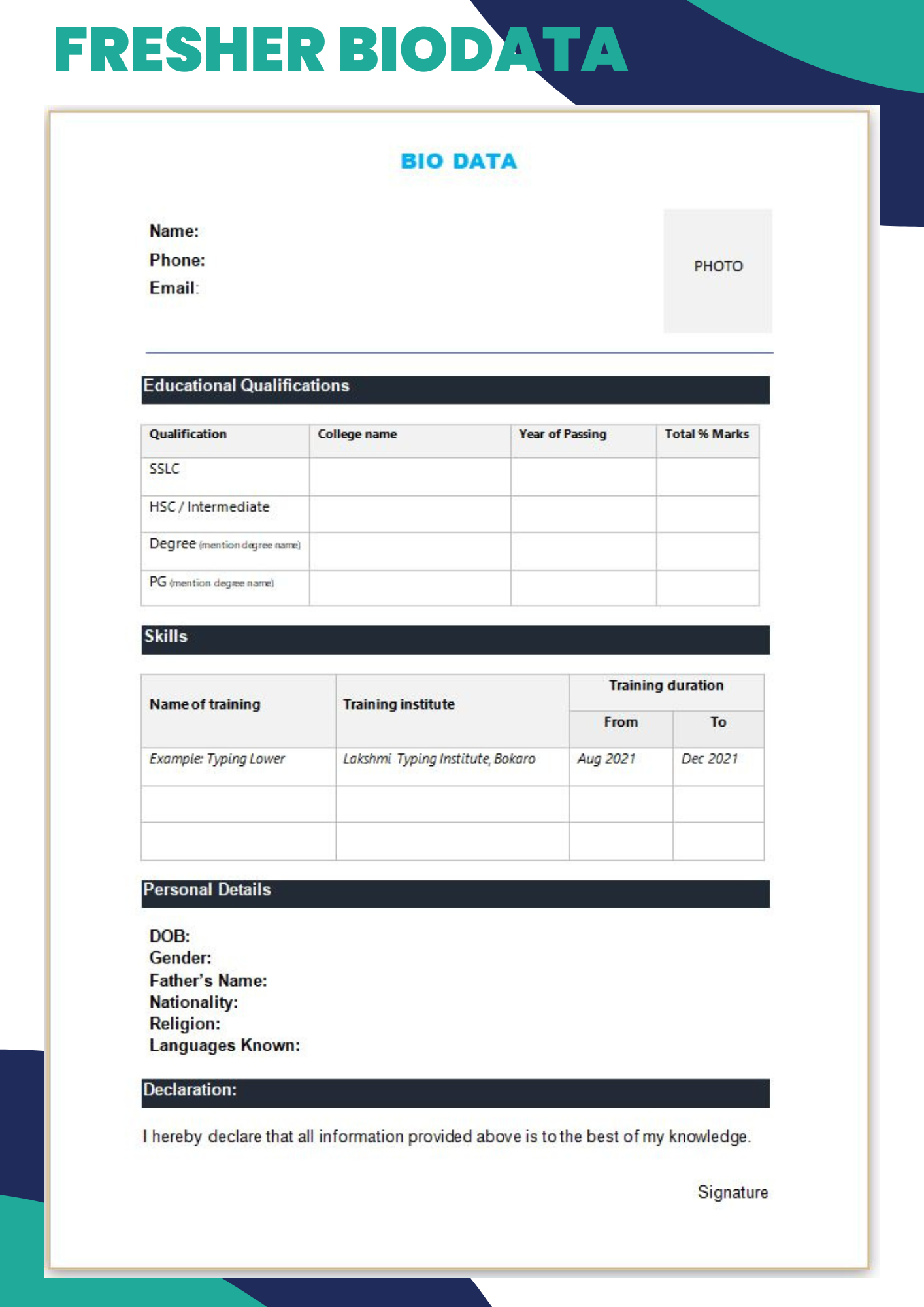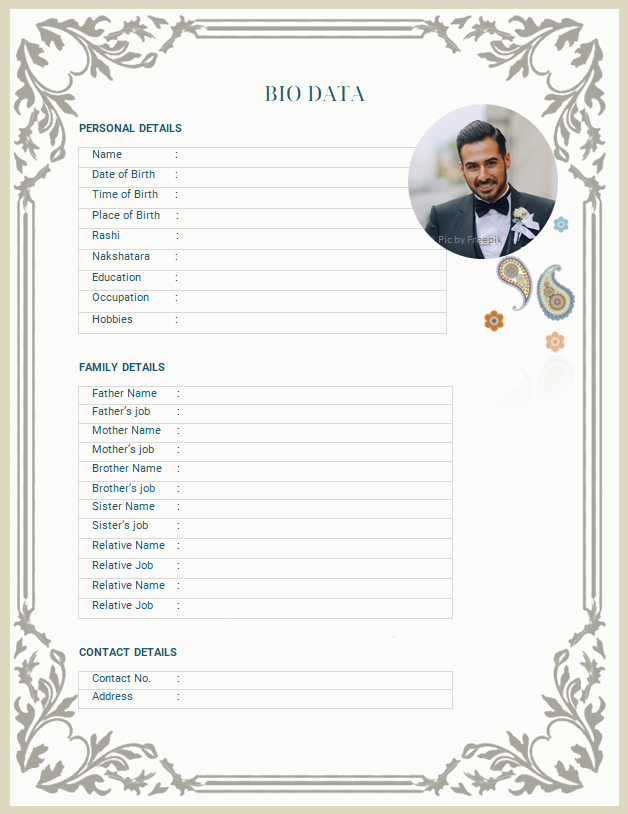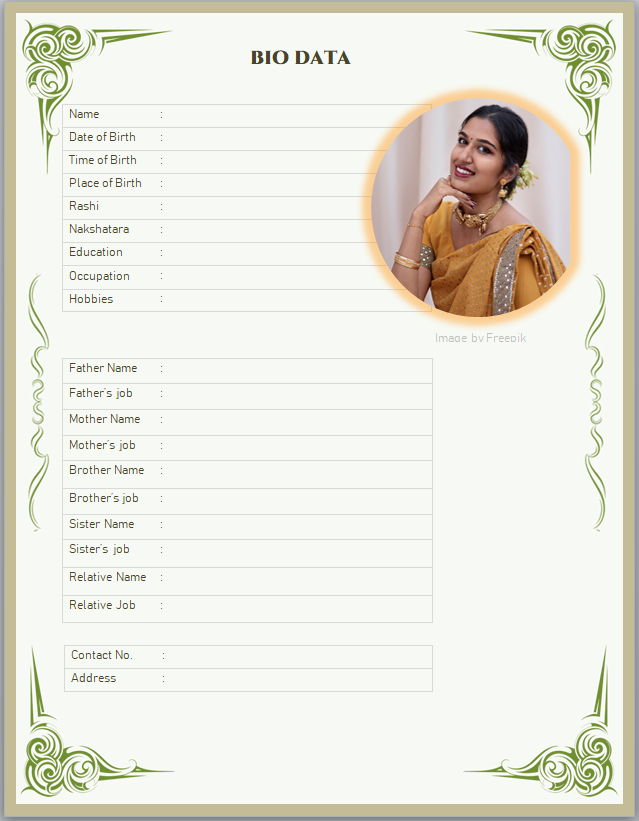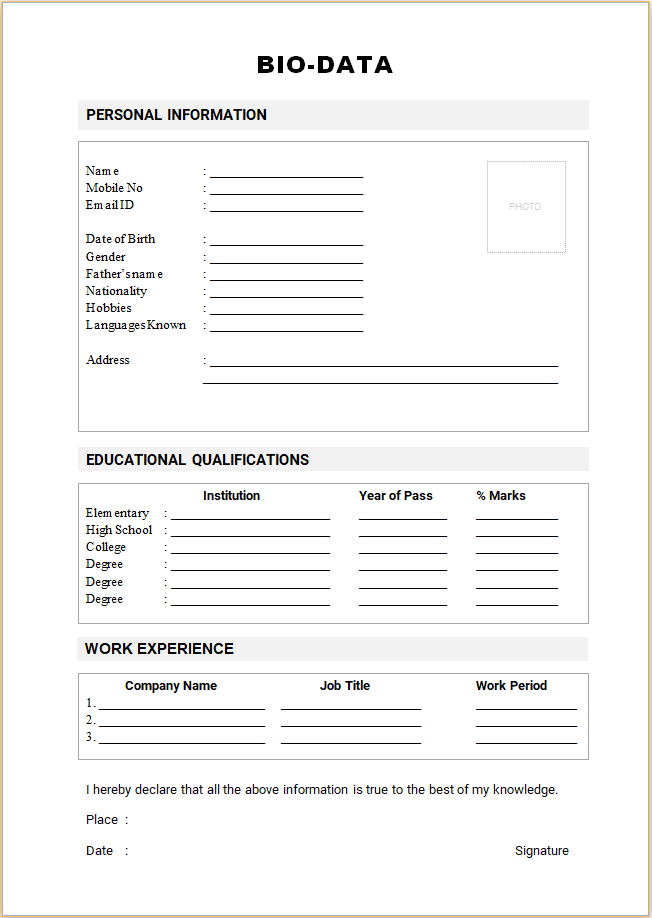Simple fresher biodata format for jobs
Fresher biodata format

Biodata format
Congratulations, if you just graduated with a degree or diploma.
You've crossed the academic finish line and are ready to take the plunge into the professional world. As you embark on the journey of job hunting, one of the first steps is creating your biodata.
Here's a guide with a special focus on highlighting your educational qualifications to make your biodata stand out.
1. Begin with a Strong Introduction:
Start your biodata with a compelling introduction. Craft a concise career objective or professional summary that captures your enthusiasm and outlines what you bring to the table. This is your chance to make a strong first impression.
2. Prioritize Your Educational Background:
As a fresh graduate, your educational qualifications take center stage. List your degrees in reverse chronological order, starting with the most recent. Include the name of the institution, degree earned, major, graduation date, and any academic honors or awards.
3. Showcase Relevant Coursework:
Highlight specific courses or projects that are directly related to the job you're applying for. This gives employers insight into your practical knowledge and how it aligns with the requirements of the position.
4. Emphasize Academic Achievements:
If you've earned any special recognitions, scholarships, or distinctions during your academic journey, make sure to highlight them. Academic achievements demonstrate your dedication and excellence in your field of study.
5. Include Extracurricular and Leadership Roles:
Don't just focus on grades. If you held leadership positions in student organizations, participated in clubs, or contributed to community service, showcase these experiences. They reflect your well-rounded personality and soft skills.
6. Relevant Internships and Projects:
While fresh graduates may lack extensive work experience, you likely have completed internships or hands-on projects. Describe these experiences in detail, emphasizing the skills and knowledge gained during these practical ventures.
7. Certifications and Additional Training:
Include any certifications or additional training you've acquired. This could be related to your field of study or industry. Certifications demonstrate your commitment to continuous learning and can set you apart from other candidates.
8. Tailor Your Biodata for Each Application:
Customize your biodata for each job application. Emphasize the aspects of your education that are most relevant to the specific position. This tailored approach shows employers that you've carefully considered how your background aligns with their needs.
9. Demonstrate Problem-Solving Skills:
Use examples from your academic experiences to highlight your problem-solving skills. Discuss how you tackled challenging projects, overcame obstacles, and applied critical thinking to achieve success.
10. Keep it Concise:
While you want to showcase your educational achievements, keep your biodata concise. Aim for a one-page document that captures the most relevant details. Employers value clarity and efficiency in resume and biodata writing.
AS you know, your educational qualifications are your assets as a fresh graduate. Use your biodata to showcase not only what you've learned but also how your academic journey has prepared you for success in the professional realm. Tailor your biodata to reflect your unique strengths, and best of luck on your job search journey!
Additional Inputs
Biodata is often the go-to format for holders of technical qualifications such as ITI and Diploma.
If you are one of them, you may want to consider stressing on your technical qualifications as well.
When crafting your biodata, it's essential to highlight the technical aspects that showcase your skills and make you stand out as a qualified candidate. Here are specific technical elements to emphasize:
Technical Skills:
Create a dedicated section to showcase your technical skills. This could include proficiency in software tools (AutoCAD, SolidWorks, etc.), hands-on experience with machinery and equipment, and knowledge of industry-specific software.
Engineering Software Proficiency:
Highlight your proficiency in relevant engineering software. Mention specific tools you're skilled in, such as CAD (Computer-Aided Design) software, simulation tools, or any other software commonly used in the mechanical engineering field.
Hands-On Experience:
If you've gained practical experience during your diploma program, whether through internships, projects, or labs, emphasize this. Describe the hands-on work you've done, showcasing your ability to apply theoretical knowledge in real-world scenarios.
Engineering Drawings and Documentation:
Mention your expertise in creating engineering drawings, schematics, and technical documentation. This is crucial in many mechanical engineering roles and demonstrates your ability to communicate technical information effectively.
Materials and Manufacturing Knowledge:
Showcase your understanding of materials used in mechanical engineering and your knowledge of manufacturing processes. This could include experience with materials selection, machining, and fabrication techniques.
Mechanical Systems Knowledge:
Highlight your understanding of mechanical systems, including knowledge of thermodynamics, fluid mechanics, heat transfer, and other fundamental principles relevant to your field of study.
Problem-Solving and Analytical Skills:
Provide examples of how you've applied problem-solving and analytical skills in your studies or projects. Describe any challenges you encountered and how you successfully resolved them.
Relevant Coursework:
List specific courses that are directly related to the job you're applying for. This could include courses in machine design, dynamics, control systems, or any other coursework that aligns with the requirements of the position.
Technical Projects:
If you completed notable technical projects during your diploma, describe them in detail. Discuss the goals, your role, the tools and techniques used, and the outcomes or results achieved.
Certifications and Training:
Mention any relevant certifications or additional training you've completed. This could include workshops, seminars, or certifications in specific technical areas that enhance your skill set.
Safety Awareness:
Emphasize your commitment to safety protocols and awareness. Mention any training or coursework related to occupational safety and health practices.
Numerical and Analytical Abilities:
Highlight your proficiency in using mathematical and analytical tools for problem-solving.
This could include proficiency in mathematical modeling, data analysis, and statistical methods.
Tailor your biodata to align with the specific requirements of the job you're applying for, emphasizing the technical aspects that make you a strong candidate in the field of mechanical engineering. By showcasing your technical skills and experiences, you'll provide potential employers with a clear understanding of your capabilities and readiness for the workforce.


